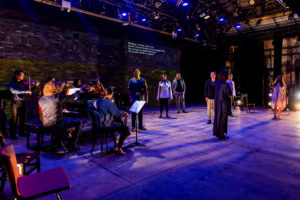
Bare Opera 2022 Review: Thomas Cabaniss’ ‘FireSongs’
By Chris RuelIn February 2022, OperaWire got a sneak peek at Thomas Cabaniss’ new song cycle, “FireSongs” at Bare Opera’s season opening gala. Cabaniss took to the stage himself and sang a few selections, and in doing so, brought the audience inside of his creative process.
Cabaniss, in a June 2022 interview with OperaWire, stated, “I spend a lot of time speaking, reciting, mumbling and shouting the text of a lyric. This is best done alone. I improvise a lot, again, usually alone, but now at the piano. Once I have a “half-baked idea,” I try to design the piece that contains this spirit of my favorite improvisations.”
Cabaniss’ selections for Bare Opera’s gala weren’t half-baked, and it was enlightening and endearing to hear the composer sing his own music, and though he may beg to differ, he didn’t do a poor job of it. The enlightening aspect was seeing him in creative action, so-to-speak. He wasn’t composing on the spot, but illustrating his process through sharing, hearing him as he would sound in his studio. It was endearing in its vulnerability. Sometimes, a composer is also a vocalist, but, as is more often the case, they are not. So, to stand in front of an audience and sing a few excerpts from FireSongs said something about his enthusiasm for the work. He transmitted his joy to the audience simply and with deep sincerity.
Fast forward to the event Bare Opera managing director and co-founder, Kristen Scott, evangelized at the gala: the world premiere of “FireSongs.” The premiere, held on June 18, 2022, Bare Opera along with National Sawdust and Chelsea Factory presented two staged shows at New York’s in Chelsea Factory. Creative Director Malena Dayen and Music Director David Rosenmeyer helmed the production that featured theatrical elements not typically seen in art song performances, including movement, ensembles, lighting and camera effects, props, and projections, though the last of these are becoming more prominent.
Is “FireSongs” an Opera or Song Cycle?
“FireSongs” is not an opera, and while, yes, it’s art song, it doesn’t fit neatly into that box either because of its staging. Creative director and vocalist Malena Dayen told OperaWire in February that Bare Opera was “really excited to show a different take of what a song cycle can be in a space where the singers are moving and not stationary, even when not singing.” In the June OperaWire interview, Dayen stated what most attracted her to the project was “the challenge of staging art songs.”
Bare Opera, a company that hangs its hat on its no frills, accessible presentation of works delivered on the promise of “FireSongs.” The staging was sparse, comprising nondescript chairs (the props); the movement was intentional and choreographed in a manner that, for the most part, expressed the text and music through the human voice and body, not inscrutably, but illustratively. The ensembles acted as a quasi-Greek chorus, amplifying understanding and providing further statement of the themes within Cabaniss’ songs. Captivating, real-time camera work added depth and drama to the projections, which mostly were impressionistic images of landscapes. Dayen’s song staging challenges became the audience’s joy.
As noted, “FireSongs” is a song cycle, but staging aside, there are pieces within that fit very much in the mold of arias and choruses. And while one consistent story doesn’t emerge throughout the piece as a whole, the individual sections are, indeed, stories. If you walked in on the performance, without knowing it was a song cycle, there’d be no crime in thinking it was a semi-staged chamber opera.
The “cast” comprised eight vocalists, and an expanded string quintet: two violins, viola, cello, and bass, along with percussion and piano. Leading them all was music director David Rosenmeyer. Entrances and exits of the instrumentalists were executed creatively, sometimes with members entering one at a time, and adding their instrument to those already gathered around Rosenmeyer at the piano. Bare Opera’s creativity extended to the way the orchestra tuned. Rosenmeyer, at the piano, improvised while members tuned their instrument’s voices in typical fashion. Then something cool happened. As if to prove the band was ready, all instruments came together and resolved the light chaos with a splendid major chord. In a unique way, tuning was the opening of the cycle, figuratively and literally. Musical power emanated from the mundane act undertaken by all orchestras. The potency of understatement can’t be overstated. When a piece called for orchestra, the musicians huddled around Rosenmeyer in intimate music making.
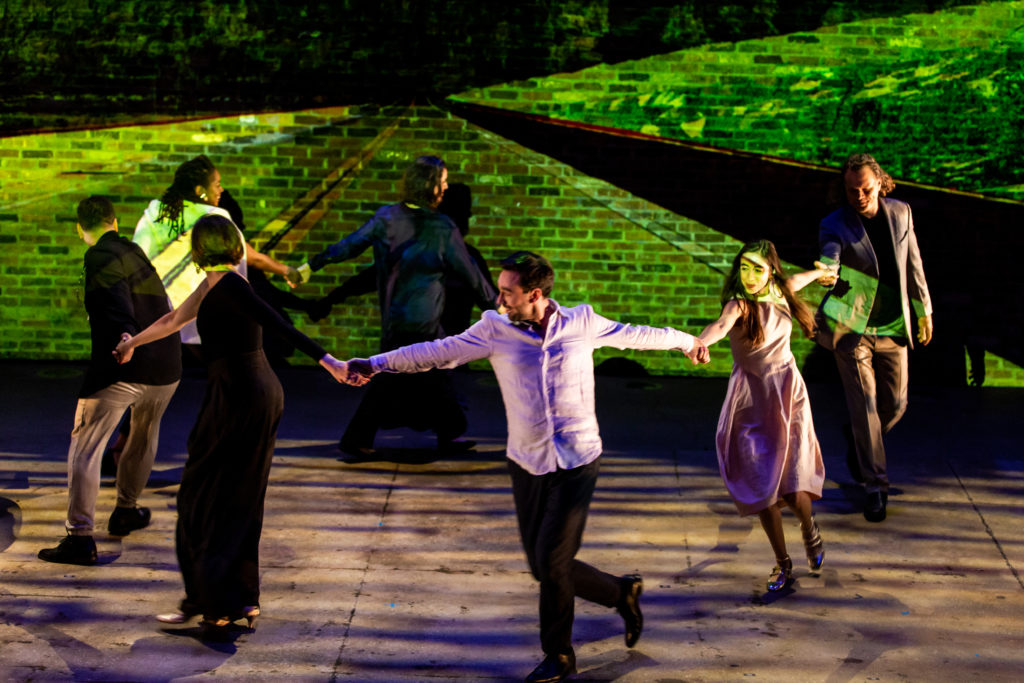
Cabaniss as Painter and the Structure of “FireSongs”
As a composer, Cabaniss is a painter, his brushes are piano keys, and his paint the notes placed on the staves. “FireSongs” is his finished painting, an image of the human experience. Some of it is abstract, like the images of landscapes projected on the rear wall, but much of it is plain as day. It’s a work of tremendous beauty, and an experience crafted by Dayen. These elements worked hand in hand to deliver an insightful view of the human condition in all its beauty and brutality.
Cabaniss divided “FireSongs” into four sections: “Opening,” begins with a passage from Walt Hudgins’ adaptation of the Biblical book of Jeremiah, before segueing into multiple texts by Robert Louis Stevenson, and one by Josephine Pinckney. “Opening” centers on the future, the universe, and the ups and downs of romantic love.
Section II, “Fires” speaks of war, violence, and conflict. Its music is tumultuous, and Cabaniss bookends the section with Walt Hudgins’ Jeremiah adaptation.
Section III, “Isolation” comprises three poems by Wendell Berry. Here, Cabaniss wrote the music collaboratively with his mentor, Mel Marvin, during the dark days of the pandemic to connect when connection seemed impossible.
Section IV, “Rebirth” includes texts from poets not yet heard prior, with poems by former Poet Laureate of the United States, Tracy K. Smith, and Evelyn Lowe, a senior citizen and member of Respond Incorporated Senior Center in Camden, New Jersey. Lowe, who wasn’t a poet but had a fine ear for words and a lifetime of experiences under her belt, passed away before hearing the final work; however, her family was present for the piece’s premiere with The Philadelphia Orchestra. Concluding the section, we see a return to W. H. Auden’s poetry with “Funeral Blues” and Walt Hudgins’ adaptation of Jeremiah with “Balm in Gilead.”
Closing out the song cycle is Mark Strand’s “The End,” a coda that brought the entire cast and instrumentalists together and left the audience with a question of sorts. Let’s look at the cycle in its entirety. Keep in mind that each piece flowed into the next. The songs were both discrete stories in themselves and part of a larger theme. Movement between numbers were entrances and exits, not unlike those in an opera.
Section I: “Opening”
“Today I Have Set You” with text from Walt Hudgins’ adaptation of the Biblical book of Jeremiah featured the eight vocalists as an ensemble
The mood was dark, foreboding, and bells tolled, marking not an ending but a beginning. The music had a dirge-like tempo, with the low notes sounding from the piano reinforcing the gravity of the text, which is straightforward.
“The day is coming/It is already here/Today, I have set you/over mountains and kingdoms/To destroy and shatter/To build and to plant.”
Cabaniss’ music was accessible and dramatic, growing in feeling as it climbed toward its climax before settling down. Cabaniss has a regional rhythm within his creative consciousness. As he stated in his OperaWire interview, he was “born and raised in the Lowcountry of South Carolina, all my music has the DNA of the rhythms that are native to the place.”
Overall, the ensemble was tight, well-formed, and mixed beautifully.
“The Infinite Shining Heavens” showcased soprano Shanelle Woods singing text by Robert Louis Stevenson. The song opens with a plaintive cello solo wonderfully played by Mara Navas, before Rosenmeyer took the lead at the piano. Contemplative in its musical language, the text speaks of the wonders of the stars and the heavens.
“The infinite shining heavens/Rose and I saw in the night/Uncountable angel stars/Showering sorrow and light.”
Wood’s voice is thrilling. It was a treat to hear her preview the piece at the February gala, and likewise, as part of the entire work.
“Spring Song” a second poem by Robert Louis Stevenson, was sung by tenor David Charles Tay.
Tay’s voice was brassy, full, and the tessitura sat well. Rosenmeyer kept dynamics in control, never overpowering the vocalist. Musically, the piece featured cascading rhythms like a spring stream flowing down a mountain. There was jauntiness and an upbeat, faster tempo than the tune preceded it.
“The air was full of sun and birds/The fresh air sparkled clearly/Remembrance wakened in my heart/And I knew I loved her dearly.”
Spring has arrived, and with it, love. The cast danced around, as if there was an invisible Maypole, clasping hands and moving in and out like a joyful jellyfish.
A third poem by Robert Louis Stevenson, “She Rested By The Broken Brook” featured baritone Marcelo Guzzo.
This number used First live footage as the camera passed alongside the cast, as if the audience were walking down the street. It ends with a closeup of Dayen, giving a sideways glance of longing? Or perhaps, remembrance? Was Dayen acting the part of the woman the narrator of the text speaks of?
“She vanished. In the sounding town/Will she remember, too?/Will she recall the eyes of brown/As I recall the blue?”
The piano line flowed like the brook by which she rested, with the rhythm serving the melody. The mood was wistful, quiet, and introspective, and had a hymn-like quality.
Cabaniss’ composition kept Guzzo’s in his middle to upper range and he appeared comfortable with the tessitura. If you think a baritone voice is too heavy for a gentle song, Guzzo would prove you wrong. His sound was tender and vulnerable.
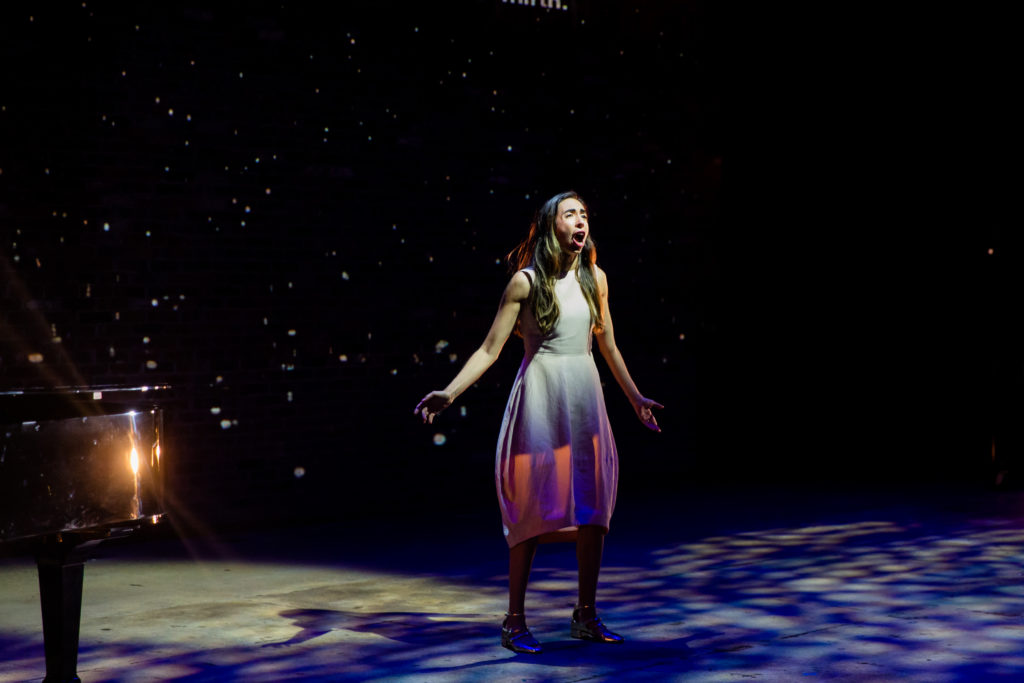
Mezzo-soprano Eugenia Forteza performed “Song For A Bridal” with text written by Josephine Pinckney. The words speak of a bride awaiting her groom on their wedding night.
“Stars and the dew and night/And earth’s deep song is sweet/My heartbeat’s quickening flight/Echoes your coming feet.”
For this number, the chairs become a key prop set up like rows for a wedding. Forteza’s earthy lower range and clear, crisp middle-and upper played and intersected with the text. Cabaniss used jaunty, fun rhythm when the text speaks of dancers and mirth. Big chords grounded the piece and rippling glissandos embellished the harmony joyously. Forteza matched the mood and text with excitement, expectancy, and anticipation.
“When I Loved You” performed by Chanan Ben Simon featured a poem Walt Hudgins—a poet whose work shows up frequently in “FireSongs.”
This was a straight-up loved-and-lost ballad sung sweetly and delicately by Ben Simon, whose voice is gentle, and sits between the tenor and countertenor range. The unique sound was perfectly matched with the text. While musically, the piece had a quasi-Broadway feel.
The mood is melancholy as the narrator speaks of how the world appeared different while in love. Once that love ends, the beauty of the sky, the sea, and the earth with which he equated his ardor return to sadly normal. Everything has lost its magic.
“When I loved you/And you loved me/You were the earth, the sky, the sea/Now the earth is earth, and sky is sky/And sea is nothing but the sea.”
Cabaniss has the violins gently float down between verses and also fill in the top, while Rosenmeyer’s played with light fingers, allowing Ben Simon to showcase one of the more memorable tunes of the evening.
“In A Time” with text by Maya Angelou was sung by mezzo-soprano Malena Dayen. Cabaniss opens the piece with solo cello, an instrument he seems to favor, and employs well for maximum emotional impact.
Malena Dayan’s mezzo is bright and big with a touch of vibrato. It has a stand-up and take notice sound. The soft, plaintive cello could have easily been drowned out by Dayan’s voice, yet they worked in tandem—in conversation with one another. The mood is darker than the prior songs—more cynical.
“In a time of furtive sighs/Sweet hellos and sad goodbyes/Half truths told and entire lies/My conscience echoes thunder.”
Section II: “Fires”
The demarcation between Sections I and II is the tone of the music. “Opening” spoke of wonder, joy, love and sadness, while “Fires” dove into conflict and war. Cabaniss’s music becomes more strident, more intense. As with “Opening,” “Fires” opens with a Walt Hudgins adaptation of the prophet Jeremiah’s words.
Baritone Marcelo Guzzo returned to sing the first piece in the section “My Song Is A Fire,” with text by Walt Hudgins
This opening tune is full of strife and anguish, and Guzzo carried it well with a more robust sound than heard in his first solo. In the text, there is anger, there is a cry for war, and Cabaniss’ music is asymmetrical, less melodic and more chaotic in nature.
“… My heart is throbbing/I cannot keep quiet/For I have heard the trumpet call/And the cry of war!”
Guzzo duels with the piano played pointedly by Rosenmeyer. There are stabs, jabs, and tension, above which Guzzo rode in bumpy, rage-filled passages. Comparatively speaking, this is Cabaniss’ least accessible numbers, where the melody is difficult to find amid the disjointed rhythms. Even so, it wasn’t hard on the ears, and there’s a break from the chromaticism in the third stanza where the tempo slows, melody appears, and the chaos resolves. In the final stanza, Guzzo goes solo, and is quite exposed, but his voice was rock solid, confident in tone and delivery. Range-wise, Cabaniss stretches the baritone by writing for the upper range.
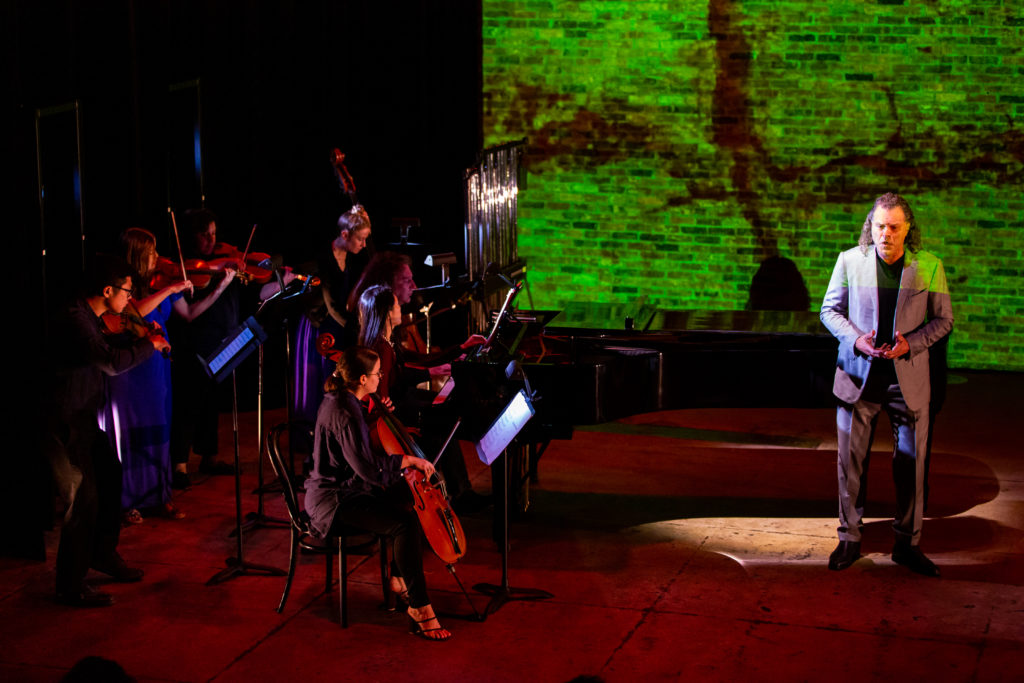
Soprano Inna Dukach made her first solo appearance in “Up Then, You Virgins,” with text by Heinrich von Kleist and adapted by Douglas Langworthy.
In contrast to the preceding song, “Up then” opens with less fire as Dukach calls upon Achilles. Immediately following her invocation, the sounds of coming war emerge. The tempo speeds to a frenzy.
As the music progressed, members of the cast walked toward the back wall and genuflected, placing their fist to their chests. These were oaths and the cast’s movement, while having religious overtones, were not, unless you view fidelity to the death of Achille’s as such.
“Achilles… Achilles…/Let me see him grovel in the dirt/You gods, I’ll give up every joy on earth/If you would only grant me this.”
Sound -wise, Dukach’s was Dayen’s soprano counterpart. It’s powerful, ringing, and in this case, full of fire and rage. Cabaniss wrote the tessitura high, and Dukach had no issues rising to the music’s demands, particularly when it required the soprano to sustain notes above the staff, which she did unfaltering. If “FireSongs” were an opera, this piece was its rage aria.
“O What Is That Sound” with text by W. H. Auden was sung by soprano Shanelle Woods.
Similar to “Up then,” the piece has a mechanistic feel in the piano line, a relentless sonic engine that pushes the music forward. The narrator speaks of an army’s preparation for war, their movement, their gear, their horses. This is a stormy, thunderous piece, mixing the tonal with the chromatic that whipsaws the listener. The storm settles, silence descends, and Woods sings the ending line with little to no backing.
‘“O what is that sound which so thrills the ear/Down in the valley, drumming, drumming/Only scarlet soldiers, dear/As they step lightly.
The twist in this piece is that as the narrator watches the army maneuver, she doesn’t realize the soldiers are headed her way.
With “Now I Will Make My Words” David Charles Tay returned and it was a standout piece for the tenor.
We return to Hudgins’ adaption of Jeremiah. The passage is dark, speaking of the ultimate destruction of a fortified town, with threats to steal food, sons, daughters, flocks, herds, vines—lay waste to everything in their path. It’s terrifying in a way that differs from the rage of “Up then.” It’s quieter, with deep bass notes in the piano, and the strings supporting the vocal line.
“Now I will make my words/A fire in your mouth/And make the people wood/For flames to devour.”
Tay blasts away with his rich tenor, soaring like a trumpet call. The tessitura is high, (Tay used his head voice for the highest notes) and Tay runs straight for them rather than shying away.
In the score, Cabaniss has placed some fantastic high strings to complement the pounding bass notes, a driving force of the piece, while the violins added a riverine flow, full of tension and turbulence.
SECTION III: Isolation
Section III is the most compact of the four, featuring just three songs performed by Forteza and Castel. The songs featured are compositions co-written by Cabaniss’ mentor Mel Marvin. These are “pandemic” pieces, penned during the isolation of lockdowns and separation from friends and family. Cabaniss and Marvin would send each other unfinished passages, which then became fully formed through the collaboration. “Isolation” became a way for both composers to have human and artistic connection during a time when the world was quite bleak. The text features three poems by Wendell Berry.
“Stay Home” performed by baritone Anicet Castel with text by Wendell Berry shifts gears. The tempest of “Fires” has dissipated, giving way to more serene passages.
Eugenia Forteza appears but doesn’t sing; she’s projected on the rear wall. Filmed in real time against a green screen, Forteza makes a ghostly appearance within the image projected on the wall. It’s a desert-like landscape through which she walks, searchingly as the narrator implores his love to stay home, saying she can find him in the fields, and in the woods and trees. This is what Forteza is presenting to the audience as she walks. She is looking to nature for company.
“I will be standing in the woods/where old trees/move only with the wind… In the stillness of the trees/I am at home. Don’t come with me/You stay home too.”
Cabaniss and Marvin’s composition have dreamy passages, foregrounding the projection of Forteza behind Castel. The piece is lovely in its lyricism, with sweet legato phrases. It was refreshing to hear a baritone take on a gentle piece that could have fit well with a tenor.
After her “walk,” mezzo-soprano Eugenia Forteza emerges from back stage to perform “To Know The Dark,” with text by Wendell Berry.
Gentle solo piano opens this short number that put Forteza in the spotlight. Forteza sang with nuance and brought out the dark tones in her voice to match the text’s subject. Cabaniss called for solo piano to back the singer, and Rosenmeyer led Forteza through the darkness. The piano line laid down a path, sounding notes that the mezzo repeated. It was as if the piano line was telling Forteza, “go here.” “Now go here.”
“To know the dark, go dark. Go without sight/and find that the dark, too, blooms and sings…”
Rosenmeyer had a very light touch on the keys, and Forteza and the pianist were very much in synch. This is notable because overall, the piano line was sparse—sounding notes before going silent as Forteza took over. When the two entered together, if they were off by smidge, it would’ve been noticeable. This was an exceptional example of a pianist and vocalist acting in tight concert (no pun) with each other. Rosenmeyer showed himself to be a highly collaborative accompanist.
Baritone Castel returned to the stage to sing “The Peace Of Wild Things,” with text by Wendell Berry. Joining him was Forteza, who now laid on the floor in a circle of light. An overhead camera projected her on the rear wall as she spun about in the circle, assuming various poses. It was, in some ways, reminiscent of a clock. The projection provided an alternative view of Forteza, with the audience able to watch the mezzo from the vantage point of their seats while also gaining a new perspective from the camera placed above. Like the earlier projection of Forteza, it was inventive and clever.
Cabaniss’ music echoed that of the song’s title: peaceful, contemplative, and ripe with word painted imagery. Once more, a baritone showed once more that the voice type can negotiate quiet, emotionally moving pieces.
SECTION IV: “Rebirth”
“An Old Story” showcased mezzo Malena Dayen singing the words by Tracy K. Smith. The number opens with the sound of cascading broken chords, and Dayen reins in her powerful voice at first, but pulls out the stops on the last two lines of the opening stanzas.
“Livid, the land, and ravaged, like a rageful/Dream. The worst in us having taken over/And broken the rest utterly down.”
Cabaniss briefly quotes the opening bars of Beethoven’s Symphony No. 9. His reason for doing so is opaque, and seemed separated from the text, and the music that followed; a jazzy/spiritual tune born in the South Carolina Lowcountry. It was a strange mixture that worked.
Unexpected poet Evelyn Lowe wrote the text for “Peace Is Mine,” which was performed by soprano Shanelle Woods.
With the opening lines: “Lately I’ve been riding the angel of death/The dark angel carries me,” you might expect a morose tune, but the composition is anything but. Lowe presaged her own passing, and ironically, the work is introspective, serene, and reveals a certain acceptance of what lay in front of her, and us all. What’s interesting in this section named “Rebirth” there’s much talk of death and sorrow. Yet, out of sorrow, out of death, comes rebirth, and that’s the thrust of the section.
“Lately, I habe been stepping on the separate line/And when I cross over/I will leave/I will leave/Leave this old world behind.” “Peace is mine/Peace is mine/All of the time/Peace is mine.”
Woods treated the subject with equal serenity, with an angelic quality in her voice. When she sings the words, “I surrender/I surrender,” her sound mirrors the text with dove-like peacefulness.
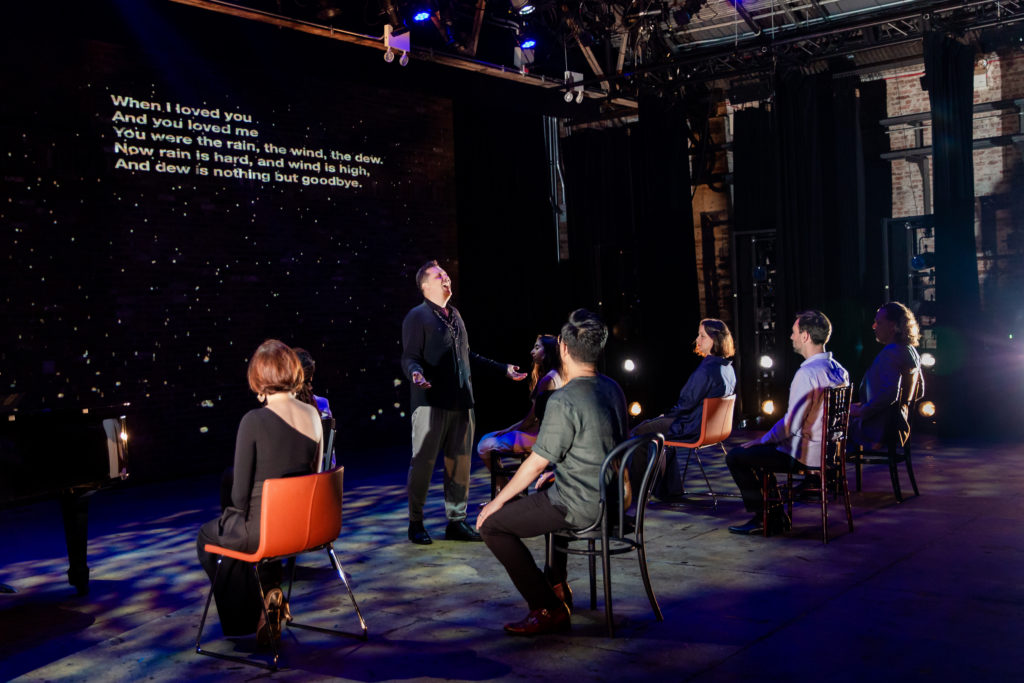
“Funeral Blues,” with text by W.H. Auden, and sung by Chanan Ben Simon showed that Cabaniss enjoys playing with different styles. With “Funeral Blues,” he gives the audience an almost Broadway feel to a composition about death and love. The piano takes a back seat as the musicians have moved to center stage, with Ben Simon standing just outside the semi-circle. The strings are lush, the setting lyrical, and upbeat—incongrous, yes, but it worked, and there are some lighthearted passages in the text.
“Let aeroplanes circle moaning overhead/Scribbling on the sky the message ‘He is Dead.’”
Ben Simon did an admirable job, but he appeared more tentative with “Funeral Blues” than with “When I loved You.” He has a unique sound and shouldn’t hide it. This is more of an encouragement rather than a ding on his performance.
For “Balm In Gilead,” soprano Inna Dukach sings the words of Walt Hudgins’ Jeremiah adaptation. “Balm” is a dirge, a lamentation with Dukach’s exquisite soprano voice drifting above that of the ensemble. The tune itself had echoes of “Dieu! Dieu D’Israël!” from Saint-Saëns’ “Samson et Dalila,” and text’s subject isn’t far off either as Dukach and crew hope for healing balm to soothe their tear-weary souls. Dukach delivered in her upper range, as Cabaniss used the strings to create a lush backdrop.
“Sorrow overtakes me/My heart fails me/Listen to the cry of the daughter of my people/It sounds throughout the land.”
CODA
The full ensemble sang “The End,” with words by Mark Strand. “The End” was just that, literally and figuratively. As the coda, the piece sums up the larger themes presented in “FireSongs”— joy, wonder, discovery, love, sorrow, and death comprise our existence. Sometimes, you need two of those experiences to create another, such as rebirth out of sorrow and death, or joy and wonder to leading to discovery. There will come a time in which our days on earth are done, and we set sail for whatever awaits us. “The End” indirectly asks what song we will sing at the end.
“Not everyone knows what is waiting for him, or what he shall sing/When the ship he is on slips into darkness, there at the end.”
With sailing ships used as the core imagery in Strand’s poem, an abstract image of the inky sea filled the back wall. The image became even more so when activated by sound. Waves became wave forms, sound became image, and the cycle came to its conclusion.
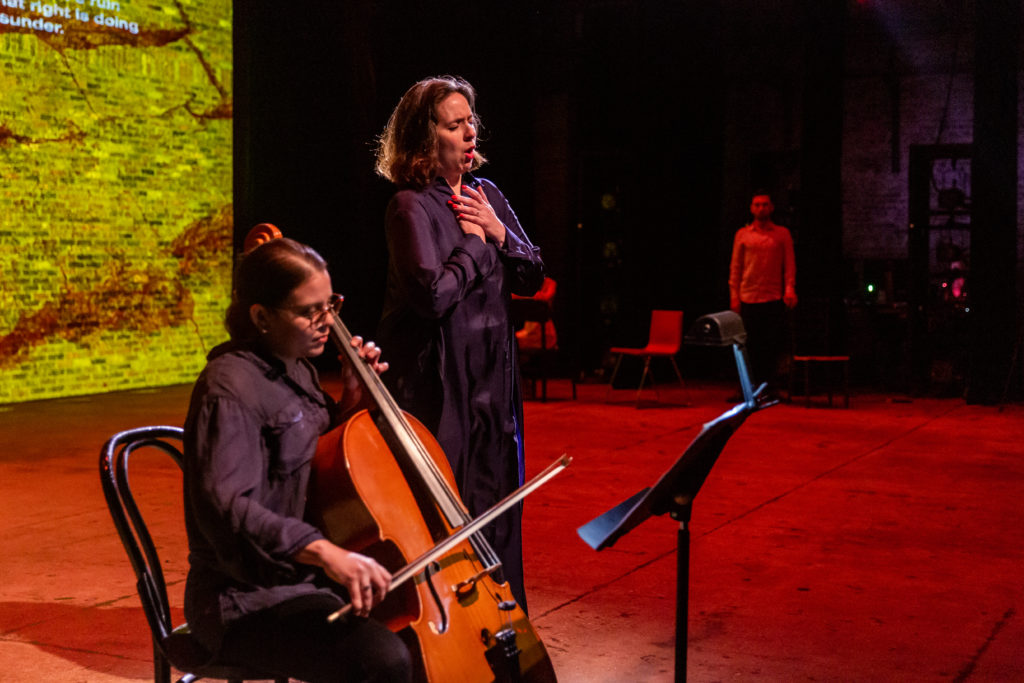
The Creatives
It would be remiss to not mention the great work of the creatives who played crucial roles in the presentation of “FireSongs.” Pianist Dura Jun took over the keys when Rosenmeyer had conducting duties. The two were true partners in music making. Troy Ogilvie served as choreographer, and made art song come alive through movement. The wonderful original artwork projected throughout the show was created by Guadalupe Marín Burgin. The projection designer was Sangmin Chae whose live camera work was compelling and original. The show’s lighting designer was Devin Cameron, who knew just the right hue in which to cast the performers in the best light.
Members of the orchestra included violinists Doori Na and LiubaLena Gonzalez, violist Molly Goldman, cellist Mara Navas, bassist Saskia Lane, and percussionist Maiko Hosoda.



